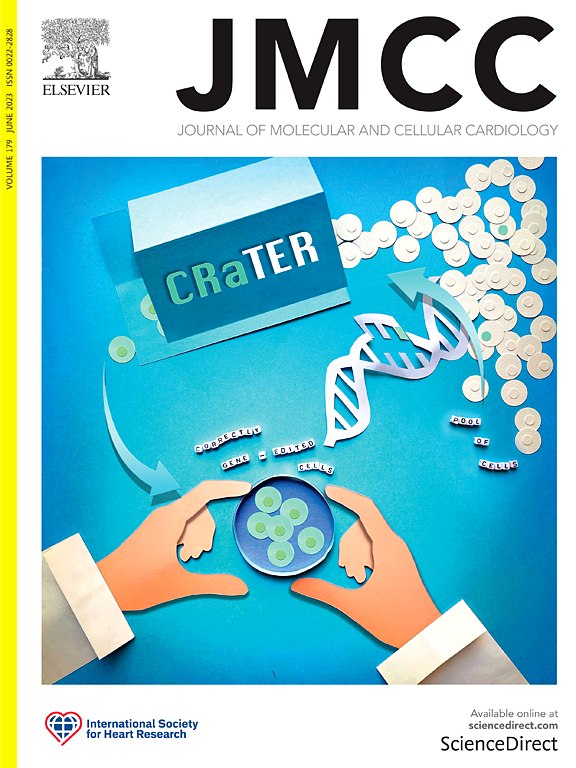人工程心脏球体膜电位和钙瞬态的光遗传刺激和同步光学定位。
IF 4.7
2区 医学
Q1 CARDIAC & CARDIOVASCULAR SYSTEMS
引用次数: 0
摘要
光遗传刺激结合膜电位(Vm)和钙离子瞬态(CaT)光学图谱是一种强大的电生理工具。我们开发了一种新颖的实验平台,在该平台上,组织受到光遗传刺激的同时,Vm 和 CaT 也会同时成像。Vm 指示剂是一种有机染料,而 CaT 指示剂是基因编码的。我们使用包含由人类诱导多能干细胞分化而成的心肌细胞和成纤维细胞的心脏球体作为模型组织。这些球形体在基因上编码了光遗传致动器 CheRiff 和钙指示剂 jRCaMP1b。Vm指示剂是有机染料RH237。CheRiff 使用蓝光(450 纳米)激发,RH237 和 jRCaMP1b 使用单波段绿光(525-575 纳米或 558-575 纳米)激发。荧光发射由两台照相机分割和成像(CaT:595-665 nm;Vm:>700 nm)。成功地对球体进行了光遗传刺激,并使用两个激发光波段同时记录了 Vm 和 CaT,没有发生串扰。525-575 nm 波段产生的信噪比高于 558-575 nm 波段,但由于 CheRiff 的激活,组织兴奋性略有增加。光遗传致动器和 CaT 指示器是基因编码的,可以在工程组织构建物中表达。相比之下,Vm 指示剂是一种有机染料,可以染色任何组织。该系统非常适合研究工程组织移植物与宿主组织之间的耦合,因为这两种组织类型可以独立受到刺激,而且组织激活可以明确归因于移植物或宿主。本文章由计算机程序翻译,如有差异,请以英文原文为准。

Optogenetic stimulation and simultaneous optical mapping of membrane potential and calcium transients in human engineered cardiac spheroids
Optogenetic stimulation combined with optical mapping of membrane potential (Vm) and calcium transients (CaT) is a powerful electrophysiological tool. We developed a novel experimental platform in which tissue is stimulated optogenetically while Vm and CaT are imaged simultaneously. The Vm indicator is an organic dye, while the CaT indicator is genetically encoded. We used cardiac spheroids containing cardiomyocytes and fibroblasts differentiated from human induced pluripotent stem cells as model tissue. The spheroids were genetically encoded with an optogenetic actuator, CheRiff, and the calcium indicator jRCaMP1b. The Vm indicator was the organic dye RH237. CheRiff was excited using blue light (450 nm), and both RH237 and jRCaMP1b were excited using a single band of green light (either 525–575 nm or 558–575 nm). Fluorescence emission was split and imaged by two cameras (CaT: 595–665 nm; Vm: >700 nm). The spheroids were successfully stimulated optogenetically and Vm and CaT were recorded simultaneously without cross-talk using both excitation light bands. The 525–575 nm band produced higher signal-to-noise ratios than the 558–575 nm band, but caused a slight increase in tissue excitability because of CheRiff activation. The optogenetic actuator and CaT indicator are genetically encoded and can be expressed in engineered tissue constructs. In contrast, the Vm indicator is an organic dye that can stain any tissue. This system is well-suited for studying coupling between engineered tissue grafts and host tissue because the two tissue types can be stimulated independently, and tissue activation can be unambiguously attributed to either graft or host.
求助全文
通过发布文献求助,成功后即可免费获取论文全文。
去求助
来源期刊
CiteScore
10.70
自引率
0.00%
发文量
171
审稿时长
42 days
期刊介绍:
The Journal of Molecular and Cellular Cardiology publishes work advancing knowledge of the mechanisms responsible for both normal and diseased cardiovascular function. To this end papers are published in all relevant areas. These include (but are not limited to): structural biology; genetics; proteomics; morphology; stem cells; molecular biology; metabolism; biophysics; bioengineering; computational modeling and systems analysis; electrophysiology; pharmacology and physiology. Papers are encouraged with both basic and translational approaches. The journal is directed not only to basic scientists but also to clinical cardiologists who wish to follow the rapidly advancing frontiers of basic knowledge of the heart and circulation.

 求助内容:
求助内容: 应助结果提醒方式:
应助结果提醒方式:


